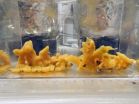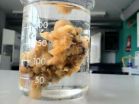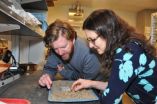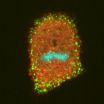(Press-News.org) One of science's strongest dogmas is that complex life on Earth could only evolve when oxygen levels in the atmosphere rose to close to modern levels. But now studies of a small sea sponge fished out of a Danish fjord shows that complex life does not need high levels of oxygen in order to live and grow.
The origin of complex life is one of science's greatest mysteries. How could the first small primitive cells evolve into the diversity of advanced life forms that exists on Earth today? The explanation in all textbooks is: Oxygen. Complex life evolved because the atmospheric levels of oxygen began to rise app. 630 – 635 million years ago.
However new studies of a common sea sponge from Kerteminde Fjord in Denmark shows that this explanation needs to be reconsidered. The sponge studies show that animals can live and grow even with very limited oxygen supplies.
In fact animals can live and grow when the atmosphere contains only 0.5 per cent of the oxygen levels in today's atmosphere.
"Our studies suggest that the origin of animals was not prevented by low oxygen levels", says Daniel Mills, PhD at the Nordic Center for Earth Evolution at the University of Southern Denmark.
Together with Lewis M. Ward from the California Institute of Technology he is the lead author of a research paper about the work in the journal PNAS.
A little over half a billion years ago, the first forms of complex life - animals - evolved on Earth. Billions of years before that life had only consisted of simple single-celled life forms. The emergence of animals coincided with a significant rise in atmospheric oxygen, and therefore it seemed obvious to link the two events and conclude that the increased oxygen levels had led to the evolution of animals.
"But nobody has ever tested how much oxygen animals need – at least not to my knowledge. Therefore we decided to find out", says Daniel Mills.
The living animals that most closely resemble the first animals on Earth are sea sponges. The species Halichondria panicea lives only a few meters from the University of Southern Denmark's Marine Biological Research Centre in Kerteminde, and it was here that Daniel Mills fished out individuals for his research.
"When we placed the sponges in our lab, they continued to breathe and grow even when the oxygen levels reached 0.5 per cent of present day atmospheric levels", says Daniel Mills.
This is lower than the oxygen levels we thought were necessary for animal life.
The big question now is: If low oxygen levels did not prevent animals from evolving – then what did? Why did life consist of only primitive single-celled bacteria and amoebae for billions of years before everything suddenly exploded and complex life arose?
"There must have been other ecological and evolutionary mechanisms at play. Maybe life remained microbial for so long because it took a while to develop the biological machinery required to construct an animal. Perhaps the ancient Earth lacked animals because complex, many-celled bodies are simply hard to evolve", says Daniel Mills.
His colleagues from the Nordic Center for Earth Evolution have previously shown that oxygen levels have actually risen dramatically at least one time before complex life evolved. Although plenty of oxygen thus became available it did not lead to the development of complex life. Read more about this work here: http://sdu.dk/en/Om_SDU/Fakulteterne/Naturvidenskab/Nyheder_2013/2013_10_16_oxygenfossil.
INFORMATION:
The link for the news story will be available when the embargo lifts and it will be this: http://www.sdu.dk/en/Om_SDU/Fakulteterne/Naturvidenskab/Nyheder/2014_02_17_sponge_oxygen
TV clip is available here:
http://youtu.be/tPBvsA3J0Cc
https://filesender.deic.dk/filesender/?vid=33c8961e-2613-68c9-fac6-00004c330e50
Contact: Daniel B. Mills
Ph.D. Candidate
Nordic Center for Earth Evolution
University of Southern Denmark
Skype: daniel.mills.nordcee
Mobile: +45 26 39 78 88
dmills@biology.sdu.dk
http://www.nordcee.dk/
Ref article: PNAS: The oxygen requirements of the earliest animals. Daniel B. Mills, Lewis M. Ward, CarriAyne Jones, Brittany Sweeten, Michael Forth, Alexander H. Treusch and Donald E. Canfield. February 17, 2014.
What is complex life
Complex life differs from primitive life forms such as bacteria and amoeba in several ways - primarily in that they are multicellular, and that cells can differentiate and specialize. Examples of complex life include animals, plants and fungi.
Theory on origin of animals challenged: Animals needs only extremely little oxygen
2014-02-18
ELSE PRESS RELEASES FROM THIS DATE:
Researchers warn against abrupt stop to geoengineering method
2014-02-18
As a range of climate change mitigation scenarios are discussed, University of Washington researchers have found that the injection of sulfate particles into the atmosphere to reflect sunlight and curb the effects of global warming could pose a severe threat if not maintained indefinitely and supported by strict reductions in greenhouse gas (GHG) emissions.
The new study, published today, 18 February, in IOP Publishing's journal Environmental Research Letters, has highlighted the risks of large and spatially expansive temperature increases if solar radiation management ...
First biological marker for major depression could enable better diagnosis and treatment
2014-02-18
Teenage boys who show a combination of depressive symptoms and elevated levels of the 'stress hormone' cortisol are up to fourteen times more likely to develop major depression than those who show neither trait, according to research funded by the Wellcome Trust.
In a study published today in the Proceedings of the National Academy of Sciences, researchers from the University of Cambridge have identified the first biomarker – a biological signpost – for major, or clinical, depression. They argue that this could help identify those boys in particular at greatest risk ...
Why tackling appetite could hold the key to preventing childhood obesity
2014-02-18
A heartier appetite is linked to more rapid infant growth and to genetic predisposition to obesity, according to two papers published in JAMA Pediatrics today (Monday).
The studies investigated how weight gain is linked to two key aspects of appetite, namely lower satiety responsiveness (a reduced urge to eat in response to internal 'fullness' signals) and higher food responsiveness (an increased urge to eat in response to the sight or smell of nice food).
The first paper reveals that infants with a heartier appetite grew more rapidly up to age 15 months, potentially ...
Ancient herring catch nets fisheries weakness
2014-02-18
Archaeological data indicate modern herring management needs to take a longer look into the past to manage fisheries for the future says a new study involving Simon Fraser University researchers.
That is one of the key findings in the study, just published online in Proceedings of the National Academy of Sciences (PNAS). SFU researchers Iain McKechnie, Dana Lepofsky and Ken Lertzman, and scientists in Ontario, Alberta and the United States are its co-authors.
The study is one of many initiatives of the SFU-based Herring School, a group of researchers that investigates ...
'It takes a village' -- Community-based methods for improving maternal and newborn health
2014-02-18
A series of studies are published in a special supplement that presents results of the Maternal and Newborn Health in Ethiopia Partnership—a three-year pilot program funded by the Bill & Melinda Gates Foundation with the goal of improving the health of Ethiopian mothers and their newborns. This special issue of the Journal of Midwifery & Women's Health is published by Wiley on behalf of the American College of Nurse-Midwives.
High mortality rates for pregnant women and newborns continue to be a major health concern in Africa, with Ethiopia being one of the most affected ...
Mitosis mystery solved as role of key protein is confirmed
2014-02-18
Researchers from Warwick Medical School have discovered the key role of a protein in shutting down endocytosis during mitosis, answering a question that has evaded scientists for half a century.
The study, published today in the journal eLife, is the first to outline the role of actin, a protein, in shutting down clathrin-dependent endocytosis during mitosis.
Endocytosis is the process by which cells absorb molecules that are too large to pass through the plasma membrane, such as proteins. Clathrin-dependent endocytosis is the most common route for this. Clathrin, a ...
Learning to see better in life and baseball
2014-02-17
With a little practice on a computer or iPad—25 minutes a day, 4 days a week, for 2 months—our brains can learn to see better, according to a study of University of California, Riverside baseball players reported in the Cell Press journal Current Biology on February 17. The new evidence also shows that a visual training program can sometimes make the difference between winning and losing.
The study is the first, as far as the researchers know, to show that perceptual learning can produce improvements in vision in normally seeing individuals.
"The demonstration that ...
Outsmarting nature during disasters
2014-02-17
The dramatic images of natural disasters in recent years, including hurricanes Katrina and Sandy and the Tohoku, Japan, earthquake and tsunami, show that nature, not the people preparing for hazards, often wins the high-stakes game of chance.
"We're playing a high-stakes game against nature without thinking about what we're doing," geophysicist Seth Stein of Northwestern University said. "We're mostly winging it instead of carefully thinking through the costs and benefits of different strategies. Sometimes we overprepare, and sometimes we underprepare."
Stein will ...
Zoonotic diseases and global viral pandemics
2014-02-17
Emergence of new microbes
While many endemic infectious diseases of humans have been largely contained, new microbes continue to emerge to threaten human and animal health. Such emerging infectious diseases are not confined to humans and their livestock but extend to wildlife ecosystems; the finely-tuned dynamic balance of which is destabilised by human interventions. The changes in the scale and manner of livestock production and marketing, the increase of global travel and trade including the trade in domestic livestock as well as the pet animal trade, the increasing ...
JCI early table of contents for Feb. 17, 2014
2014-02-17
Neurotensin conjugate provides pain relief in animal models
The small peptide neurotensin is a potent regulator of dopamine signaling and can provide dramatic pain relief; however, the blood brain barrier provides a substantial challenge toward clinical use of neurotensin for analgesia. In this issue of the Journal of Clinical Investigation, Philippe Sarret and colleagues at Université de Sherbrooke generated a conjugate of neurotensin with a peptide able to cross the blood brain barrier and evaluated the analgesic effects of this molecule in animal models of pain. The ...



